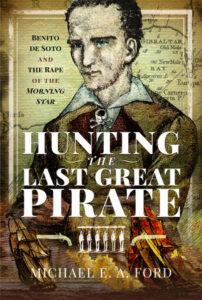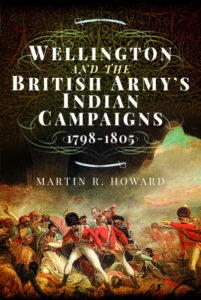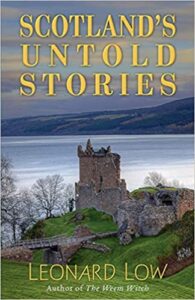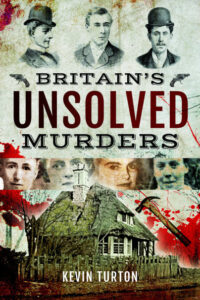
by RNS | Dec 18, 2020 | Beating Tsundoku
Michael E. A. Ford, Hunting the Last Great Pirate (Pen & Sword, 2020)
By 1827, the heyday of the pirates was long over, but piracy continued, and this new breed were every bit as dangerous as their predecessors. Enter Benito de Soto, a career pirate who attacked the British ship, the Morning Star, off the coast of Africa, killed some of its crew and took its treasure. The British hunted him down, capturing de Soto in Gibraltar, before trying and executing him. In Hunting the Last Great Pirate, Michael Ford narrates this fascinating story.
Benito de Soto was a particularly vicious pirate even for that profession. An advocate of the dead-men-tell-no-tales approach to piracy, his cruelty was limited only by opportunity. In 1827, he encountered the sluggish British merchant ship, Morning Star, near Ascension Island. After plundering it, he thought he had sunk the ship with all hands, but he was wrong. The Morning Star limped back to London, setting off a howl of protests over piracy and lack of naval protection. A convoluted series of events led to De Soto being arrested at Gibraltar in July 1828. His trial proved problematic, however, because there was little available evidence of his piracy. He therefore languished in prison until a trial could be rigged against him by the British government. De Soto was executed in January 1830. In his epilogue, Ford reveals that evidence uncovered many years after the events determined de Soto’s guilt beyond doubt, but that Spanish cooperation at the time could have made the prosecution case far safer without the need for government machinations.
That basic outline underplays Ford’s skilful weaving of a compelling multifaceted story, involving not just the base piracy at its heart, but corruption and complicity running through the British and Spanish governments. Ford deploys multiple sources gleaned from careful research to bolster his well-written account. Moreover, his novelistic approach heightens the tension in the story and avoids becoming bogged down in some of the drier aspects of the wider context. Ford’s book is a useful addition to the history of piracy and will appeal to students of early 19th century international relations and historical criminology. It is also a very good read.
BUY NOW

by RNS | Dec 16, 2020 | Beating Tsundoku
Martin R. Howard, Wellington and the British Army’s Indian Campaigns 1798-1805 (Pen & Sword, 2020)
In this detailed work, Martin R. Howard attempts to bridge a gap in the literature of the British campaigns in India during the Napoleonic period. Previous works focus on Arthur Wellesley, the future Duke of Wellington, and his actions, but Howard finds there was much more to the wars in India than that.
Howard splits his book into three sections. The first surveys the British Army in India and its enemies. The British fielded a polyglot force of Europeans, Natives, and British soldiers with the East India Company troops added to the mix. They faced two main enemies; Tipu Sultan of Mysore and the Maratha princes. Tipu had tens of thousands under his command in a well-organised army, but one that suffered from poor morale. The Maratha princes could field a decent sized army too, but they were riven by command infighting. Howard notes that the British also had to face smaller, irregular forces from time to time.
The second part examines the significant campaigns. Some of these are more familiar than others, such as the Mysore campaign of 1799 and the campaign leading to the Battle of Asaye in 1803. General Lake’s campaigns against the Maratha princes in 1803 is less well known. Howard describes these campaigns in detail with orders of battle and well laid out maps. Howard’s third section is on the soldiers’ experience of India. Howard describes the men’s reactions to the voyage and arriving in India, the heat, the stinging and biting wildlife, their encounters with the locals, mundane garrison life and the shock and violence of battle, the peculiar soldier’s life of the native sepoy, and the important medical support the army needed. Howard concludes with eight appendices, providing additional information that did not make it into his chapters.
Howard has written an invaluable guide to what we might call Wellington’s India. He played the vital role in these campaigns, though certainly not the only one. Despite the odd inclusion of lists into the main text, which arrests the flow at times, Howard writes well, and his battle narratives are particularly good. He also sprinkles illuminating primary source material throughout the text and is assisted by some first-class colour plates of scenes and major players. Anyone interested in the wars in India will want this book, as will military history students for this period in general.
BUY NOW

by RNS | Dec 14, 2020 | Beating Tsundoku
Leonard Low, Scotland’s Untold Stories (Guardbridge Books, 2020)
Imagine sitting in front of a roaring fire on a cold winter’s night in Scotland. The wind howls around the house, rain batters the windows, and your favourite uncle, sitting beside the fire, the light sparkling through his whisky glass, says “I have a story for you”. That should set the scene to read Leonard Low’s Scotland’s Untold Stories, a collection of dark tales from Scotland’s murky past gleaned from sources long since forgotten.
Low tells stories of a warrior with an iron hand, an expensive dram of whisky, cannibals, executions by drowning, duels, witch hunters, seers, a curious jail cell in a bridge, a botched execution, pirates, the white slave trade, John Paul Jones, early balloon flights, early lighthouses, a curling disaster, a brave death at Waterloo, graverobbers, wife selling, a church disaster and one in a quarry, a riot in a church, dream evidence in a murder investigation, German U-Boats, an outbreak of St. Vitus Dance in Leuchars, a lucky escape from the Moors Murderers, and Jack the Ripper in the East Neuk of Fife? Surely not!
It is customary to highlight the best and weakest stories in a compendium, but in this book Low’s selection is of consistently high quality, though credit must be given to the way he tells them. And that is also how they should be read; with an ear for cadence and rhythm as if listening to the storytellers of old. This is no accident, however, because Low has done his homework in the archives and on the ground, and he helpfully lists his sources and books for further reading where available. You can also visit many of the sites where these stories happened. Low may lean towards the romantic at times, but this is Scotland after all where we treat the darkness then with more of a weather eye now. Anyone interested in Scotland’s history will appreciate and enjoy Low’s stories and ask when volume 2 is coming out.
BUY NOW

by RNS | Dec 12, 2020 | Beating Tsundoku
Michael Graham, On Operations with C Squadron SAS (Pen & Sword, 2020)
In this, the third book on Michael Graham’s exploits in the SAS, the author takes us into the African bush to fight communist terrorists during the late 1960s and 1970s. His stories are sometimes hair-raising, sometimes amusing, but always interesting and worth reading.
The book opens by profiling the men we are about to meet and share their experiences, from General Peter George Walls down through the ranks. Next comes some maps and a brief history of the unit and its reorganisation into an effective fighting force. Then we are off and running, literally, on an account of an evasion training exercise. Active missions followed: recovering evidence, training Portuguese troops in Angola, assaulting an MPLA base, and hunting terrorists in Mozambique. In 1980, after 12 years of almost constant fighting and with defeat looming in Rhodesia, the unit disbanded with many going on to serve with the South African army. Graham also describes South African efforts to destabilize Zimbabwe and the possible assassination of guerrilla leader Samora Michel, though Graham was not involved in the latter. Graham concludes with a brief family and personal biography, culminating in his facing the reality that at the time of writing he had lung cancer and not long to live.
Graham is a terrific storyteller, writing in a journalistic style. His tales of combat are those of an authentic cold warrior fighting on the front lines of a proxy war. His perspective is personal and focused on his work, though he detours into an extended opinion of how the British let down Rhodesia after Margaret Thatcher was asked to help and refused. Fighting communists was Graham’s life for twelve years, so it is unsurprising how much he hates them, but he shows little understanding of the conflict beyond the stark realities of war. For those interested in small unit combat operations in Africa, this is a very good read.
BUY NOW

by RNS | Dec 7, 2020 | Beating Tsundoku
Kevin Turton, Britain’s Unsolved Murders (Pen & Sword, 2019)
In Britain’s Unsolved Murders, Kevin Turton presents a selection of thirteen crimes committed between 1857 and 1957. Turton sets the scene, provides a narrative of the murder and trial if there was one, then gives his verdict.
Some of the unsolved murders in Turton’s book are more famous than others; for example, the infamous Scottish verdict of ‘Not Proven’ delivered to Madeleine Smith in 1857 and the atrocious desecration of the young Bradford boy John Gill in 1888. While all of the murders contain a central mystery – who did it – a couple are truly baffling, namely the murders of Florence Nightingale Shore in 1920 and Evelyn Foster on a lonely moor in 1931. Others appear to have a more ready explanation to hand and only an investigative or trial error prevented the murderer being unmasked. In one case a jury member refused to convict the apparent murderer through his own conviction against Capital Punishment.
Turton narrates these stories in an engaging style, laying out the events in a straightforward manner. They are a good jumping off point for further reading, but some of the murders already have their own historian, most notably Diane Janes’ Death at Wolf’s Nick which is a brilliant forensic examination of an unsolved murder. A frustrating lack of footnotes and references, however, blunt further investigation by the reader into other cases. Turton also does not make it clear why he chose these murders across that particular century while leaving out many others and not including more modern cases. Given his personal edge to his verdicts, perhaps the title might be better read as Kevin Turton’s Casebook of Unsolved Crimes? Nevertheless, this works as a true crime book within that genre, but as an appetizer rather than a main course.
BUY NOW






